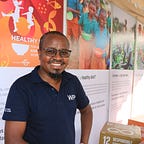An oasis in the dry plains
How Kenyan farmers are producing food amidst a severe drought
As a pro-longed drought continues to ravage the arid and semi-arid regions in Kenya, some farmers in Makueni County are coping thanks to WFP supported climate resilient technology that enables farmers to harvest and store rainwater for agricultural use.
Makueni County lies in the marginal agricultural lands in the southern part of Kenya. Families here rely on rain-fed agriculture for food. Over the years, the rains have become increasingly scant and unreliable.
“Since the late 1990s, the rains have performed poorly year after year. Today, it is common to get one or two days of heavy rain in a whole season — the rest of the days, we experience only light showers,” said Dominic Mawilo Mutunga, a farmer in Nthungu village. “This is not enough to grow food crops up to maturity.”
Dominic and his wife Dorcas make a living tilling one acre of land. Their farm resembles an oasis, a green well-tended patch surrounded by dry bare fields.
Secret to Success
Dominic and Dorcas have not always been successful at farming.
“When we moved here in 1985, the rains were sufficient, but the seasons started becoming unreliable. There are years that we planted and harvested nothing at the end of the season,” said Dominic.
Dominic joined WFP’s asset creation activities in 2012. The community then was involved in rehabilitating land destroyed by soil erosion using terraces as well as digging rectangular pits to conserve rainwater. The farmers added manure to the pits to improve soil fertility. The trapped water and the fertile soil would support a crop where none could have grown. In return for the days worked, WFP gave the families an incentive in the form of food rations and starting in 2015, a cash transfer.
In 2014, WFP introduced ‘farm ponds’ as a rainwater harvesting technology with the intent of collecting water for irrigation. Through asset creation, communities provide labour to excavate the farm pond while WFP donates the tarpaulin for lining the farm pond to prevent water loss through seepage and a shade net to reduce evaporation. Dominic was among the first farmers to adopt this technology.
“Whenever it rains, a lot of surface run-off water goes to waste. The water washes away the fertile top soil draining into rivers and finally into the Indian Ocean,” said James Kamunge WFP’s Programme Policy Officer. “Farm ponds are the ideal structures for collecting this water which can then be used to grow crops during the dry season as well as support other activities such as rearing chickens, agroforestry and bee keeping.”
Dominic, with the assistance of three other families completed digging and lining a farm pond in 2015, after six months of communal work. This marked their turning point.
Crops all year round
Dominic’s farm pond can store up to 25,000 litres of water at full capacity. One or two heavy rains are enough to fill the pond. He and his wife can then use this to grow food all year round.
“We are growing water melon, chilies, tomatoes, cowpeas, onions, paw paws, amaranth, kale, and mangoes,” said Dorcas proudly. “We sit and agree on what to plant. Onions, tomatoes and cowpeas do very well, but kale can be challenging due to pests and diseases. Amaranth is my cash crop. It doesn’t need a lot of care and I can harvest and sell daily.”
The mango crop is not yet in season, but Dominic and Dorcas have already made their first sale.
“We’ve been taught how to grow mangoes off-season — when there is not a lot of the fruit in the market— so we can take advantage of the high and good market prices,” said Dorcas.
Food secure
“We never lack food throughout the year — even during the driest months,” said Dorcas proudly. “I sell the vegetables in the local market to meet our needs. During the dry periods, a bunch of vegetables will go for about 100 Kenyan shillings (about US$1).”
Dominic and Dorcas have put their five children through school with proceeds from the farm. From the current crop of mangoes, they expect to make at least 50,000 Kenyan shillings (US$500).
“In this area, if one does not invest in the modern methods of farming and storing rainwater — such as terraces, moisture-conserving pits full of rich soil, or a farm pond — it is impossible to get any meaningful yield,” said Dominic.
Dominic is at the final stage of improving the water storage efficiency of his farm pond. With the support of the Swedish International Development Cooperation Agency (SIDA) and the United States Agency for International Development (USAID) channeled through WFP, he is covering the lined farm pond with a shade-net to prevent loss of water through evaporation.
“I will continue farming and ploughing back the profits to the farm. I also intend to plant trees around the farm and expand the area under crop.”
*****
The estimated cost of excavating a 25,000-litre farm pond, installing water abstraction and irrigation equipment is about 190,000 Kenyan shillings (US$190). The farm pond can sufficiently irrigate half an acre (0.5 ha) of land for a crop cycle of 100 days (3 months) in the dry season. It is estimated that this cost can be recovered in two to three seasons of growing kale and tomatoes for sale.
In Kenya, WFP’s asset creation activities are made possible through the generous support of: Australia, Canada, the European Commission, Finland, Germany, Italy, Japan, Kenya, Luxembourg, Multilateral Donors, Norway, Private Donors, Russian Federation, Sweden, Switzerland, UN CERF, and the United States of America.
